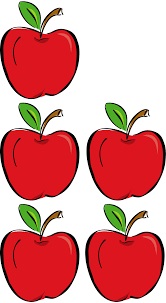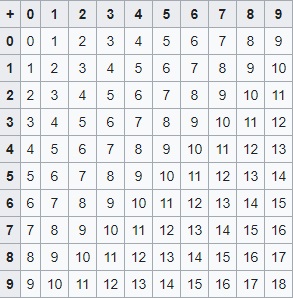|
|
| |
|
|
| |
|
|
|
|
| |
 |
| 3 + 2 = 5 with
apples, a popular choice in textbooks. |
Addition
Addition (usually signified by the plus symbol +) is one
of the four basic operations of arithmetic, the other
three being subtraction, multiplication and division.
The addition of two whole numbers results in the total
amount or sum of those values combined. The example in
the adjacent image shows a combination of three apples
and two apples, making a total of five apples. This
observation is equivalent to the mathematical expression
"3 + 2 = 5" (that is, "3 plus 2 is equal to 5").
Besides counting items, addition can also be defined and
executed without referring to concrete objects, using
abstractions called numbers instead, such as integers,
real numbers and complex numbers. Addition belongs to
arithmetic, a branch of mathematics. In algebra, another
area of mathematics, addition can also be performed on
abstract objects such as vectors, matrices, subspaces
and subgroups.
Addition has several important properties. It is
commutative, meaning that order does not matter, and it
is associative, meaning that when one adds more than two
numbers, the order in which addition is performed does
not matter (see Summation). Repeated addition of 1 is
the same as counting; addition of 0 does not change a
number. Addition also obeys predictable rules concerning
related operations such as subtraction and
multiplication. |
|
|
Performing addition is one of the simplest numerical
tasks. Addition of very small numbers is accessible to
toddlers; the most basic task, 1 + 1, can be performed
by infants as young as five months, and even some
members of other animal species. In primary education,
students are taught to add numbers in the decimal
system, starting with single digits and progressively
tackling more difficult problems. Mechanical aids range
from the ancient abacus to the modern computer, where
research on the most efficient implementations of
addition continues to this day. |
|
 |
| Addition table of
pairs of numbers from 0 to 9. |
Childhood
learning
Typically, children first master counting. When given a
problem that requires that two items and three items be
combined, young children model the situation with
physical objects, often fingers or a drawing, and then
count the total. As they gain experience, they learn or
discover the strategy of "counting-on": asked to find
two plus three, children count three past two, saying
"three, four, five" (usually ticking off fingers), and
arriving at five. This strategy seems almost universal;
children can easily pick it up from peers or teachers.
Most discover it independently. With additional
experience, children learn to add more quickly by
exploiting the commutativity of addition by counting up
from the larger number, in this case, starting with
three and counting "four, five." Eventually children
begin to recall certain addition facts ("number bonds"),
either through experience or rote memorization. Once
some facts are committed to memory, children begin to
derive unknown facts from known ones. For example, a
child asked to add six and seven may know that 6 + 6 =
12 and then reason that 6 + 7 is one more, or 13. Such
derived facts can be found very quickly and most
elementary school students eventually rely on a mixture
of memorized and derived facts to add fluently.
Different nations introduce whole numbers and arithmetic
at different ages, with many countries teaching addition
in pre-school. However, throughout the world, addition
is taught by the end of the first year of elementary
school.
Table
Children are often presented with the addition table of
pairs of numbers from 0 to 9 to memorize. Knowing this,
children can perform any addition. |
|
|
|
|
|
|
|
|
|
|
|
|
|
|
|
|
|
|
Search Fun Easy English |
|
|
|
|
|
|
|
|
|
|
|
|
|
|
|
About
Contact
Copyright
Resources
Site Map |